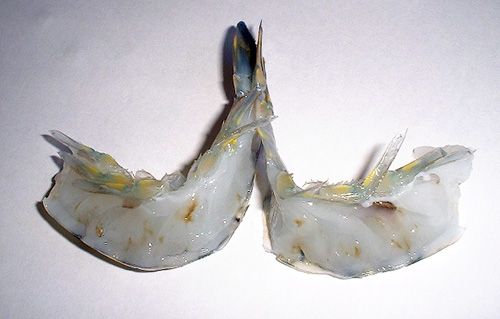Letter: Condition presents no danger to consumers
The following was adapted from a recent letter by the author in reply to an earlier message by Masao Shimomura, executive managing director of the Japan Fish Traders Association. Shimomura had requested assistance in identifying discoloration in shrimp tissue. The information is reprinted here with their kind permission.

The pictures sent to me appear to show shrimp affected by idiopathic muscle necrosis or IMN. This has also been called “brown muscle syndrome.” I have observed it on rare occasions in black tiger prawns in Thailand, but it has also been described in other penaeid shrimp and the freshwater prawn (Macrobrachium rosenbergii).
Usually, the affected shrimp represent a small portion of the total harvest. When examined under a light microscope, the muscle tissue is degraded and large numbers of shrimp blood cells (hemocytes) can be seen aggregating in the area. These hemocytes release enzymes that result in the formation of the brown pigment melanin, which is what causes the brown discoloration.
No health risk
This is a normal shrimp defense function that presents no human health danger, even though it is unsightly. In addition, it will become black on cooking and although more unsightly, it is still harmless if eaten. The situation might be likened to the brown discoloration that occurs in a bruise or on an apple after it has been cut with a knife and left exposed to the air. In other words, it indicates injured, but not rotten tissue.
In spite of the tissue damage, no bacteria, fungi, or parasites have been seen associated with the muscle degradation. It has been suggested the phenomenon might be caused by excessive stress leading to the accumulation of lactic acid (a product of muscle metabolism) to such an extent that the tissue is damaged. This is followed by the arrival of large numbers of hemocytes to clean up the damaged tissue, which causes the brown coloration.
In one of our investigations with the electron microscope, we did find what appeared to be spherical viral particles in the cytoplasm of some cells in the area of IMN, but no further work was done on this. The significance of these particles remains unknown. With M. rosenbergii, the problem appeared to be associated with stress related to overcrowding, and the problem was solved by reducing the stocking density.
Limited problem
It is hard to say what caused the problem in the shrimp. However, the extent of the phenomenon can be seen at harvest, and shrimp exporters in Thailand usually inspect samples of cultivated shrimp to determine whether significant numbers show brown muscle discoloration before agreeing on the purchase price.
This brown muscle phenomenon is not a cause for alarm to importers, as long as the number of such shrimp represents an insignificant part of the total volume imported. The affected shrimp can simply be removed and discarded because they are unsightly. They present no danger to other shrimp in the group or consumers.
(Editor’s Note: This article was originally published in the February 2003 print edition of the Global Aquaculture Advocate.)
Now that you've finished reading the article ...
… we hope you’ll consider supporting our mission to document the evolution of the global aquaculture industry and share our vast network of contributors’ expansive knowledge every week.
By becoming a Global Seafood Alliance member, you’re ensuring that all of the pre-competitive work we do through member benefits, resources and events can continue. Individual membership costs just $50 a year. GSA individual and corporate members receive complimentary access to a series of GOAL virtual events beginning in April. Join now.
Not a GSA member? Join us.
Author
-
Tim Flegel, Ph.D.
Centex Shrimp
Chalerm Prakiat Building
Faculty of Science
Mahidol University
Rama 6 Road
Bangkok 10400, Thailand
Tagged With
Related Posts

Health & Welfare
Common diseases of pangasius catfish farmed in Vietnam
As with other species, varied health problems – and treatments – related to parasites and bacteria have been encountered in pangasius catfish.

Health & Welfare
The microsporidium <i>Perezia</i> sp. and cotton shrimp disease
Study analyzes samples of microsporidia-infected shrimp in Madagascar, Mozambique and Saudi Arabia and with clinical signs of cotton shrimp disease.

Health & Welfare
A case for better shrimp nutrition
Shrimp farm performance can often be below realistic production standards. Use proven nutrition, feeds and feeding techniques to improve profitability.

Health & Welfare
A comprehensive look at the Proficiency Test for farmed shrimp
The University of Arizona Aquaculture Pathology Laboratory has carried out the Proficiency Test (PT) since 2005, with 300-plus diagnostic laboratories participating while improving their capabilities in the diagnosis of several shrimp pathogens.


